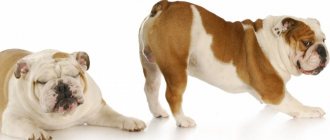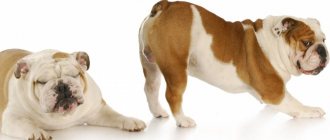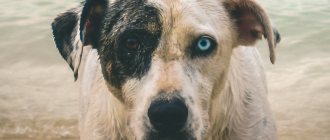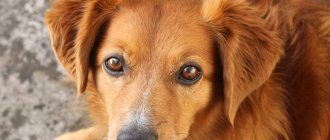We can judge the health and mood of our dog by its eyes. A healthy animal has bright, shiny, lively eyes. But suddenly you notice that your pet’s gaze has changed - it has become clouded, it has become “extinguished.”
What could be the reason for this change? This process, just like in humans, is age-related or is the dog sick? To answer this question, you need to consider the reasons that lead to cloudy eyes.
Belmo
A cataract (leukoma) is a clouding or scar on the cornea of the eye. The cause of the cataract can be either an eye disease or surgery.
Look what the thorn looks like in the photo:
Treatment
How and with what to treat, and most importantly, how to remove an eyesore? Timely (early) contacting the clinic will allow you to provide assistance to your four-legged friend faster and at a lower cost. Having identified the cause, the ophthalmologist will prescribe treatment. It can be:
- solution of chloramphenicol with hydrocartisone and novocaine or ointment with antibiotics under the eyelid,
- absorbable injections,
- corticosteroids,
- boric acid.
Any treatment can be more effective if you follow the diet prescribed by your veterinarian.
No one can stop an owner who wants to help his pet while waiting for a medical consultation. At home, complete treatment is impossible, but it is possible to relieve the dog’s discomfort and reduce pain using the following means.
How to cure a thorn at home - what to do:
- Rinsing the eyes with Metrogyl and Gamavit , placing Actovigin or tetracycline ointment under the eyelid.
- To resolve the ulcer, drops of “ Oftan ” and “ Dexamethasone ” are used.
- 1 tsp pour 100 grams of onion pulp. hot milk , leave for 8 hours, strain and instill 1 drop 2 times a day.
- Rinse with chamomile .
- of fir resin juice once a day.
The consequences of using folk remedies are very individual. Improper use may result in corneal burns. Be careful!
Sugar as medicine
Among other folk recipes for the treatment of cataracts, products containing sugar (or honey) are mentioned:
- 0.5 tsp Dissolve honey in 100 g of boiled, cooled water. Drop into eyes.
- Wash your eyes with a cooled solution of honey (1 tsp) and hot water (1 glass) 3 times a day.
- Sifted powdered sugar is blown into the affected eye 3 times a day. This procedure increases lacrimation.
Powdered sugar injection was used (and worked successfully) in ancient times to treat eyesores in horses. It is believed that the basis of this treatment is reverse osmosis (hypertonic solutions draw liquid). Amateurism in such an elegant task is not recommended - you can sift the powder incorrectly, blow it unevenly, etc.
The eye has a complex structure and requires professional treatment.
How to prevent it?
All measures aimed at protecting the dog’s eyes from mechanical and chemical influences can be considered preventive.
Symptoms
A cloudy whitish spot is the main sign of the formation of a white film. But several factors can precede its appearance and then accompany it:
- Teariness in one/two eyes.
- Separation of purulent contents.
- Photophobia (the pet hides its eyes from bright light or the sun).
- Deformation of the structure of the corneal tissue (it becomes rough).
- Partial/whole blurring of the visual organ.
- “Protrusion” of the white spot outward.
The appearance of the first pathological signs requires prompt medical intervention and determination of the cause of leukoma - the pet has obvious problems with eye health.
Glaucoma
Increased intraocular pressure leads to an imbalance between the production and outflow of moisture. There are primary and secondary glaucoma. Primary can be congenital or acquired. Secondary - is the result of inflammation of the anterior chamber of the eye.
Photo
Symptoms
The main signs of this pathology include:
- Increased tear production.
- Redness of the whites.
- Swelling, “bulging” of the eye - it seems to have become larger.
- Apathy, lethargy.
- Decreased corneal brightness.
- The dog constantly whines when the area near the eye is touched.
- Loss of appetite.
- Reluctance to establish contact with other animals and people.
- Sometimes the pet seems to be lost in space.
- The desire to constantly be in the dark.
There are enough reasons for the development of the disease:
- Displacement of the lens;
- Inflammation of any part of the eye;
- Neoplasm in the eye;
- Accumulated blood after injury or surgery;
- Genetic predisposition;
- Keratitis or conjunctivitis if not treated.
How to treat: the best drugs
As in all cases of deciding on treatment methods, the decisive question is the timing of contacting a specialist.
In the early stages of glaucoma, drug treatment with drugs . The process is long and, at best, can stabilize intracranial pressure. A cure cannot be expected - the disease affects all components of the eye. Medications will slow down the process of clouding of the eye, but it will not be possible to restore vision or even stop the development of the disease.
Beta blockers, osmotic diuretics, miotics and inhibitors are used as therapeutic drugs; they will be prescribed by a veterinarian.
- To urgently reduce intraocular pressure (during an attack), a drug from a series of osmotic diuretics, “ Mannitol ,” is recommended. Application allows you to retain water for about 4 hours.
- What drops are needed to treat glaucoma? The external use of carbonic anhydrase inhibitors is aimed at reducing moisture production and, as a result, reducing blood pressure. Systemic drugs Dorzolamide and Brinzolamide have no side effects and are recommended for daily use.
At a late stage of the disease, the doctor’s task is to avoid complete loss of vision and reduce the pain that the dog experiences when IOP increases. When the disease is advanced, the only correct solution is surgical removal of the entire visual organ.
The results of glaucoma treatment in animals are incomparably lower than in humans . Surgeries to increase the outflow of aqueous humor (they are associated with the implantation of drainage tubes into the eye) or, conversely, to reduce the production of moisture (partial destruction of the ciliary body with a laser) quite often do not give the expected effect. In the end, when choosing between the painful inevitable loss of vision for a pet and removal, the doctor chooses the second. A prosthesis is implanted for cosmetic purposes.
Prevention
In order to prevent such a serious disease with irreversible consequences, dog owners are advised to monitor the condition of their pet’s eyes, promptly and completely cure conjunctivitis and keratitis, and conduct regular examinations with a veterinarian.
For what reasons can this formation appear?
Dogs' eyes become cloudy for a number of reasons:
- congenital pathology (extremely rare);
- due to injury;
- inflammatory process;
- consequence after an illness;
- the result of improper treatment of purulent inflammation.
Spots and clouds appear most often due to improper home treatment. A cataract is a consequence of purulent inflammation. There are also medications that contain lead, silver and zinc - after their use, small stains appear and they cannot be treated.
Attention! It cannot be ruled out that some breeds are predisposed to cloudy eyes. These include pugs, Pekingese, Labradors, and bulldogs.
Cataract
This eye disease is associated with aging of the lens, a violation of its transparency - subnuclear (nuclear) sclerosis.
The development of cataracts is most likely at the age of 8 years, when the elasticity of the lens decreases, it hardens and ceases to adjust vision to different distances. It is more common in Golden Retrievers, Poodles, Yorkshire Terriers and Boston Terriers. The disease progresses over the years.
Cataract photo:
Causes
Less commonly, the causes of cataracts are heredity. Acquired cataracts occur after trauma, after inflammatory diseases, diabetes, etc.
Symptoms, treatment and diagnosis
An external sign of cataract is clouding of the lens. The cloudiness of cataracts is uneven. It is possible to recognize cataracts on your own. When a beam of light hits the affected eye, the clouding will shrink in size. In low light, on the contrary, it increases.
In some cases, this dangerous disease can develop for a long time without visible symptoms. But a dog owner may notice decreased vision by analyzing the dog's behavior.
The most reliable way to diagnose an eye disease called cataracts remains to be examined by a specialist.
Treatment without surgery
How to treat cataracts without surgical intervention at home? But no way. The use of medicinal drugs does not allow us to hope for the recovery of our four-legged pet. At best, the progression of the disease will slow down. It is possible to use drugs only at the very beginning of the development of cataracts, when surgery is not yet required. Vitamins and enzymes are usually prescribed.
Cataracts cannot currently be prevented. Do not fall for the tricks of deceivers who recommend Smirnova eye drops, vitaiodurol, vicein, catachrome, vitafacol for the treatment of cataracts . These drugs cannot prevent, slow down, or even cure clouding due to the fact that the nature of the disease is not clear.
When is cataract surgery necessary?
The only effective way to treat cataracts is surgery to replace the clouded lens with an artificial one. From a technical point of view, this operation is very complex. Its result largely depends on the stage at which the application was made to an ophthalmologist. Obviously, earlier treatment guarantees a better result.
The modern technology of lens removal using ultrasound - phacoemulsification - is finding more and more fans. But it is also effective in the early stages.
Prevention
The need for surgery is determined by the animal’s ability to navigate in space using vision. If decreased vision does not allow the dog to move without the threat of harm to health, we can talk about the need for urgent surgical treatment.
- When purchasing a puppy, you should ask whether any of the parents have been diagnosed with cataracts.
- After 6 years, it is necessary to regularly visit a veterinarian.
- Maintain eye hygiene for your pet: wipe and apply eye drops if indicated.
- A nutritious diet and adherence to the vaccination schedule are also important.
Types of disease and photos
A cataract is a scar formation. A type of pathology is scar spots, which differ in density and size:
- The spot is clear, transparent, small.
- The cloud is translucent and blurry.
- A cataract is a dense thick spot of gray or milky hue.
This pathology is dangerous for a dog; due to sprouted blood vessels, the cornea is subject to deformation. Vision disappears completely or partially.
In addition to scar formations, there are other types of pathologies. Among them are:
- Corneal ulcer – can be superficial, deep, or descemetocele. A through lesion of the eye occurs.
- Keratitis is an inflammatory process in the cornea.
- Degeneration – deposition of calcium salts, cholesterol.
- Endothelial dystrophy is a disease unique to old dogs.
- Endothelial edema - the pupil becomes blue. This happens after vaccination.
- Cataract – the lens begins to become cloudy.
- Glaucoma - at the initial stage the eyeball becomes enlarged, and then clouding is observed.
Attention! The deeper the lesion, the less pain. If a pet squints and then stops, this does not mean that everything has passed.
Film
White cloudy
If a dog's eye is covered with a white film, then most likely this is a sign of problems with the third eyelid. If there is a thickening, which is a symptom of adenoma of the third eyelid, the involvement of a surgeon will be required .
What to do if a film appears - a trip to the veterinarian to determine the nature of this formation and identify visual disturbances at an early stage will be the best way out.
Transparent
A transparent film on the eyes without signs of inflammation is amyloid corneal dystrophy . May be caused by an unbalanced diet, a violation of fat metabolism. There is no need for treatment, since it does not create any inconvenience for the animal and has no consequences. There is a possibility of extinction.
After examination, the doctor may prescribe Emoxipin , 1 drop 3 times a day, for 1-2 months.
Blue
If your eye is covered with a blue film, then you should immediately go to the veterinarian! A bluish film on the membrane of the eye appears only when the eye is swollen, which occurs for several reasons and, depending on the causes, is treated using different methods. Having such a disease can be extremely painful for a dog. The treatment must be chosen by a doctor.
What is the third eyelid in dogs?
This is a structure that can elongate, partially or completely covering the eye, giving the dog the appearance of rolling its eyes, as if the eye had rotated inside the socket. This is the third eyelid with very important functions. It is located in the inner corner of the eye, is opaque and usually not visible.
It contains the lacrimal gland, which produces almost half of the total volume of tear fluid. Several causes can cause exteriorization of this membrane, such as eye pain, eye retraction, cartilage eversion, or foreign body. We need to see a vet.
A condition known as third eyelid palsy flares up. It consists of the projection of this eyelid above the eye. In some individuals this is a congenital defect. On a clinical level this is not a problem. This would only have aesthetic value for a dog wanting to compete in beauty pageants. Does not require treatment.
Lens luxation
Luxation , or luxation of the lens , is a serious disease in which the lens is displaced due to rupture of the suspensory ligaments (ciliary band) into the anterior (most often) or posterior chamber or into the vitreous body, or it is pinched in the pupil.
Symptoms:
- Pain
- Photophobia
- Tearing
- Squinting (blepharospasm)
- There may be a violation of the shape of the pupil
Treatment:
1. Immediate surgical removal of the lens, because secondary complications often develop - glaucoma and uveitis. The earlier the luxated lens is removed, the better the prognosis.
===========================================================================================================================================================================================
Prevention
The main prevention of leukoma is to avoid eye injuries from twigs, claws and other objects. Any damage to the cornea must be treated immediately; this is the only way to achieve a complete recovery. Traditional animal vaccination will not help here.
In conclusion, we note that the thorn does not threaten the life of the pet, but it complicates life. Due to the appearance of a cloudy film on the cornea, the dog loses its vision. A quick visit to an ophthalmologist and proper treatment will help the animal cope with the disease.
In addition, regular eye care for your dog is required. We recommend watching the video below to see how it is done.
Contacting a veterinarian
Often, dog owners seek qualified veterinary help too late, when the animal has already begun to lose its vision..
You must respond immediately if the following signs appear:
the animal's eyes become cloudy;- a white spot appeared on the eyeball;
- the dog is bothered by liquid or purulent discharge near the lower eyelid;
- There was an injury to the organs of vision - chemical or mechanical.
If the owner notices that the dog’s vision is deteriorating for some reason, especially at a young age, this is an alarming symptom that requires diagnosis.
Only in a veterinary clinic after a thorough examination and all research will an accurate diagnosis be made. Self-medication in this situation is not worthwhile.
Diagnostics
Treatment begins with identifying the causes of eye disease. To do this, a scraping is taken from the cornea in the place where it is damaged. This is a rather outdated method that complicates the injury to the organ of vision.
In modern veterinary practice, the following diagnostic methods are used:
- Ultrasound of the eyeball;
- herpes test;
- electroretinography;
- serology;
- parcentesis.
As soon as the results of the study are ready, therapy begins, especially if the clouding has spread to the entire area of the eye.
Dry eye
When dogs develop a condition called keratoconjunctivitis sicca or dry eye, their tear glands produce fewer tears than normal. Tears perform important functions:
- removing potentially damaging material from the surface of the eye;
- nutrition of corneal tissue.
Mild cases of dry eye can be treated with an artificial tear solution, but medications that stimulate tear production (such as cyclosporine) are usually needed.











